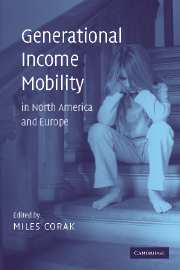Book contents
- Frontmatter
- Contents
- List of figures
- List of tables
- List of contributors
- Preface
- 1 Generational income mobility in North America and Europe: an introduction
- 2 A model of intergenerational mobility variation over time and place
- 3 Equal opportunity and intergenerational mobility: going beyond intergenerational income transition matrices
- 4 Intergenerational mobility for whom? The experience of high- and low-earning sons in international perspective
- 5 What do trends in the intergenerational economic mobility of sons and daughters in the United States mean?
- 6 Changes in intergenerational mobility in Britain
- 7 Intergenerational mobility in Britain: new evidence from the British Household Panel Survey
- 8 Non-linear patterns of intergenerational mobility in Germany and the United States
- 9 Family structure and labor market success: the influence of siblings and birth order on the earnings of young adults in Norway, Finland, and Sweden
- 10 New evidence on the intergenerational correlation in welfare participation
- 11 Intergenerational influences on the receipt of unemployment insurance in Canada and Sweden
- 12 Unequal opportunities and the mechanisms of social inheritance
- Index
- References
2 - A model of intergenerational mobility variation over time and place
Published online by Cambridge University Press: 22 September 2009
- Frontmatter
- Contents
- List of figures
- List of tables
- List of contributors
- Preface
- 1 Generational income mobility in North America and Europe: an introduction
- 2 A model of intergenerational mobility variation over time and place
- 3 Equal opportunity and intergenerational mobility: going beyond intergenerational income transition matrices
- 4 Intergenerational mobility for whom? The experience of high- and low-earning sons in international perspective
- 5 What do trends in the intergenerational economic mobility of sons and daughters in the United States mean?
- 6 Changes in intergenerational mobility in Britain
- 7 Intergenerational mobility in Britain: new evidence from the British Household Panel Survey
- 8 Non-linear patterns of intergenerational mobility in Germany and the United States
- 9 Family structure and labor market success: the influence of siblings and birth order on the earnings of young adults in Norway, Finland, and Sweden
- 10 New evidence on the intergenerational correlation in welfare participation
- 11 Intergenerational influences on the receipt of unemployment insurance in Canada and Sweden
- 12 Unequal opportunities and the mechanisms of social inheritance
- Index
- References
Summary
A rapidly growing literature, surveyed in Solon (1999), is examining the empirical association between the incomes of parents and their children. With the acquisition of new data, researchers recently have begun to explore the ways in which intergenerational income mobility varies between countries and over time. Solon (2002) summarizes the new international evidence, which is substantially expanded by several of the chapters in this book. In addition, Reville (1995), Fertig (2001), and the authors of Chapter 5 have begun to study temporal change in intergenerational mobility in the United States, and the authors of Chapter 6 address that subject for the United Kingdom. This new research on intergenerational mobility variation over time and place is important both because it documents important features and trends in income inequality and because it may produce valuable clues about how income status is transmitted across generations.
The purpose of this chapter is to present a theoretical framework for interpreting the evidence from this newly emerging literature. I begin by modifying the Becker–Tomes (1979) model in a way that rationalizes the log-linear intergenerational income regression commonly estimated by empirical researchers. Analysis of the model shows that the steady-state intergenerational income elasticity increases with the heritability of income-related traits, the efficacy of human capital investment, and the earnings return to human capital, and it decreases with the progressivity of public investment in human capital. Cross-country differences in both intergenerational mobility and cross-sectional income inequality could arise from differences in any of these factors.
- Type
- Chapter
- Information
- Generational Income Mobility in North America and Europe , pp. 38 - 47Publisher: Cambridge University PressPrint publication year: 2004
References
- 199
- Cited by



